General information:
Isfahan is known as a museum that is as big as a city! With several monuments around the city, it is a great place to enjoy the art and history of Iran. Maybe that is the reason that Isfahani calls their city, ” half of the world!” As the capital of Iran during the Safavid era (1501-1736), Isfahan is home to several historical and magnificent buildings and structures.
Naqsh-e Jahan Square, Ali Qapu, Chehel Sotoun, Si-o-Se Pol, and Khajoo bridges are some of the attractions of this beautiful city that you may hear about this.
Above all, the sparkling Zayandehrud River and dazzling bridges crossing it, traditional bazaar, historical buildings, and beautiful Chahar-Bagh pave way are strong reasons to spend days in this colorful historical city.
Besides, Isfahan is the third-largest city in Iran after Tehran and Mashhad. It is located at the intersection of .the two principal north-south and east-west routes of Iran.
How to get to Isfahan?
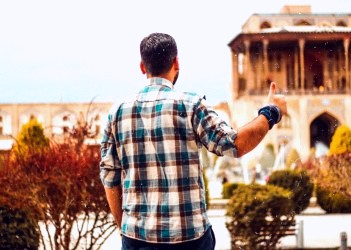
Isfahan International Airport has direct connections to 14 destinations in Turkey, Armenia, Saudi Arabia, Georgia, and Russia. In addition, domestic flights are available from most Iranian major cities. There are 16 flights per week for Tehran to Isfahan flight. The flight distance between Tehran to Isfahan is 339 km and it takes 55 minutes.
For a road trip, it is 459 km from Tehran to Isfahan for a nonstop drive. It takes about five hours. So you can have itineraries like Kashan and Qom on your way to Isfahan as well.
To explore Isfahan, besides taxi and bus there is a line of the metro that runs for 11 km from north to south of the city.
Read more: All Things You Should Know About Domestic Flights in Iran
Sightseeings
Naqsh-e Jahan Square

Also known as Imam Square, Naqsh-e Jahan is located in the heart of Isfahan. Being once a part of the palace of Shah Abbas (1571 – 1629), it is now home to several architectural wonders of Iran. Naqshe- Jahan means ‘pattern of world’ in Persian, which manifests its importance and beauty.
The two-story buildings surround the square, which was once a place for trading. With 512m long and 163m wide, it is one of the largest squares in the world and is registered on the UNESCO World Heritage site.
With fountains and gardens in the middle, the square embraces gems of Safavid architecture Shah Mosque, Sheikh Lotfollah Mosque, Ali Qapu, and Qeysarieh portal.
Besides, the whole square is pedestrian and some horse-drawn carriages and a few electric carts are available for visitors. So don’t miss the bazaar of Isfahan and souvenir shops at the place. Do not miss other attractions:
Shah Mosque
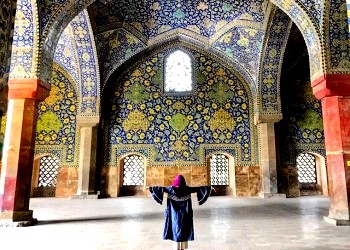
Known also as Imam Mosque, the construction was completed in 1629.
In addition, it is registered on the UNESCO world heritage site and is a great manifestation of Islamic architecture.
Besides, the place mesmerizes you with Intricate blue-tiled mosaics, glittering iwans, towering minarets, and calligraphy works on the walls.
The construction contains 18 million bricks and 475,000 tiles and employed the new haft rangi (seven-color) style of tile mosaic.
Ali Qapu

Dominating one side of beautiful Naqsh-e Jahan, Ali Qapu is a six-storey edifice with 38 m high.
Shah Abbas I built the palace in the late 16th century as a gate to his residence.
Ali Qapu boasts an elevated terrace with 18 columns. However, the gem of the edifice is the music room on the upper floor.
The room fascinates you with the stucco ceiling, which is stenciled with the shapes of vases and rose-water shakers.
It was used as a place for private ceremonies and some concerts.
Sheikh Lotfollah Mosque
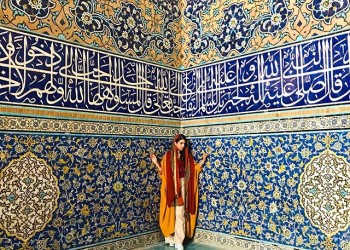
This unique mosque is known for its golden-creamy tile work and complex arabesques. The color of tiles turns into pink from sunrise to sunset.
The interesting point about this mosque is that it does not have any minarets.
That is because it was constructed for the royal family and not for public use.
The mihrab of the mosque with its unusual high niche is one of the finest in Iran.
The mosque is named after the ruler’s father-in-law, Sheikh Lotfollah, a revered Lebanese Islamic scholar who curated Shah Mosque and Isfahan theological school in the early 17th century.
Check out: Isfahan Tour in 3 Days
Si-o-Se Pol Bridge
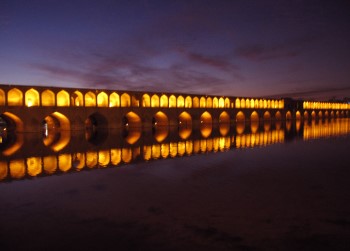
In early 17th century, the ruler of Shah Abbas I, Allahverdi Khan, ordered the building of Si-o-Se Pol, which is about 300 meter long.
During the Safavid era, five bridges are built over the Zayandehrud River.
The name of the river means 33 bridges, which indicates the number of arches on the first level of the bridge.
The upper level is a great pedestrian on which people walk and its walls protect them from falling.
Located in the heart of Isfahan, it connects Chahar-Bagh Abbasi to Chahar-Bagh Bala streets.
Khajoo Bridge
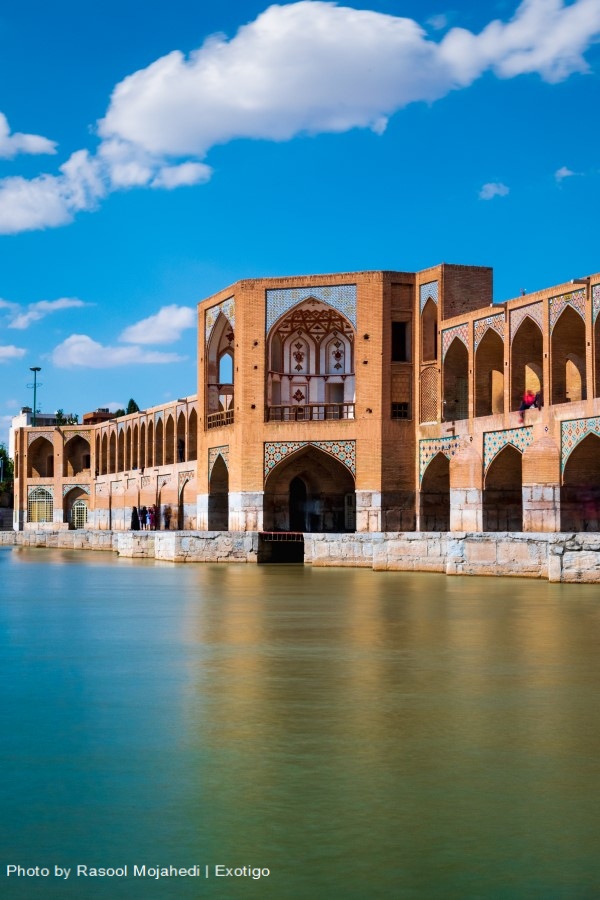
Built about 1650, Khajoo bridge still bears the paintings and tiles for the decoration. In the middle of the bridge, you can see the remaining of a pavilion for Shah Abbas II. He watched the sunset when the river was full. The bridge is also used as a dam with arcades in the lower terrace to control water.
If you visit the place at night, you can hear the sound of Isfahani citizens recite songs under its arches.
Chehel Sotoun
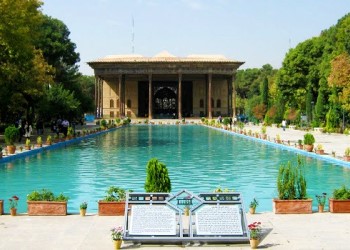
A pavilion to receive ambassadors and dignities with magic beauty! Located in a park with a pool in front of it, Chehel Sotoun have 20 ribbed wooden pillars support a superb wooden ceiling.
The number of pillars doubles with their picture in the pool, which becomes 40. That is why the place is called Chehel Sotoun, which means forty columns.
The frescoes, miniatures, and ceramics at the Great Hall are wonderful! You can see the main battles during the Safavid era depicted on its walls!
The garden of Chehel Sotoun is a great place to witness Persian garden. It is registered as one of the Iranian Persian gardens on UNESCO Heritage List.
Vank Cathedral
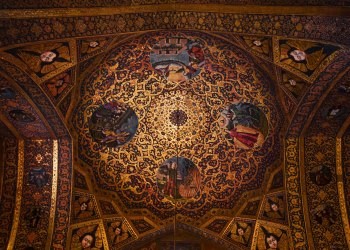
During the Ottoman War of 1603-1618, hundreds of thousands of Armenians were forcibly resettled by Shah Abbas I in his new capital, Isfahan.
Vank cathedral is also known as the Holy Savior and the Church of the Saintly Sisters. It is located in the New Julfa district of Isfahan.
The exteriors of the cathedral are in modern brickwork in contrary to the elaborately decorated interior. Frescos and gilded carvings in the interior section are really eye-catching. They depict the biblical story of the creation of the world and man’s expulsion from Eden.
The edict of the establishment of new Armenian issued by Shah Abbas and a memorial to the Armenian Genocide are kept at the museum.
Things to do in Isfahan
Let’s Isfahan bewitches you
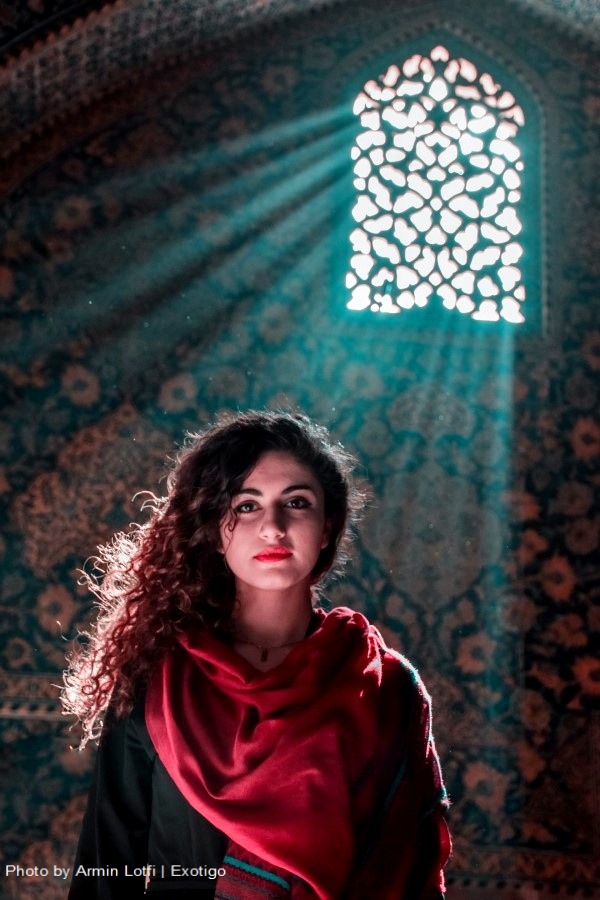
If you travel to Isfahan, do not miss the chance to walk through the city. Chaharbagh Boulevard, a historical avenue dated back to the Safavid era, is one of the must-see places in Isfahan. The six-kilometer boulevard connects the northern part of the city to the southern part.
Strolling in the traditional bazaar and watching and buying handicrafts and Isfahan souvenir can be another part of walking through the town.
Walking another Niasarm Madi (canal) is a pleasant experience enjoying water running in the canal and green trees along with it. You can also explore the Isfahan neighborhoods during your walk. Don’t forget to taste an Armenian coffee in the Jolfa neighborhood of Isfahan.
Beautiful avenues near the Vank Cathedral is a great place to visit the Armenian district of the city.
Climbing Soffeh Mountain
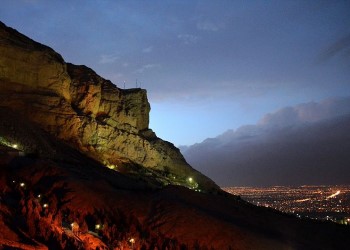
One of the best activities that you can have in Isfahan is hiking and climbing Soffeh Mountain. The place is located in southern Isfahan and you can reach the peak in two hours. You can climb the mountain without any equipment. From above, you can have a great view of the city. You can find some beautiful waterfalls and caves near the peak.
If you are not a fan of mountain climbing, there are a variety of entertainment on the foothill of Soffeh. Cable cabin, bowling hall, playground, and restaurants are available there. You can also meet Isfahani families coming to the place for picnic.
Try Goosh-e Fil and Doogh
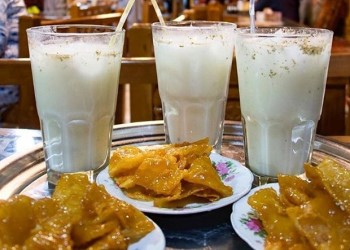
Actually it is a weird combination for most or Iranians as well!
You can find such a pair in most of Isfahan’s coffee shops and juice shops. First of all, let’s understand what these two are!
Goosh-e Fil, which means elephant’s ear in Persian, is a kind of doughnut deeply fried.
It is called Goosh-e Fil because of its shape.As you can guess, it is very sweet.
On the other hand doogh, a cold drink of curdled milk and water, is somehow have salty taste.
In Isfahan, people eat these two different tastes together. So if you travel Isfahan, don’t miss this unique experience!
Read more: Some 15 Best Things to Do in Iran
Lodging in Isfahan

Abbasi Hotel
It is a five-star luxury and historic hotel in Isfahan. It is one of the oldest hotels in Iran. With the unique architecture of Chahar Baq School, Abbasi Hotel is dated back to the Safavid era (151-1736). It is a caravanserai as a part of a complex that includes a school, bazaar, and caravanserai.
The Abbasi hotel has 225 rooms and suites, including standard single and double rooms, Cheshm-Andaz and Paradise rooms, Sabaz, Pardis, Qajar, and Safavid suites, and two and three-bedroom apartments.
All the rooms are equipped with special safety systems and have shower, dressing room, high-speed WI-FI, LCD television, hairdryer, safety box, coffee, and tea maker, minibar, and fire detector systems.
Atigh Traditional Hotel

The hotel dates back to 200 years ago and is on Iran’s national heritage list. The hotel is located in the Shahshahan old neighborhood.
It is adjacent to the beautiful Atigh mosque and is a wonderful place with two courtyards.
Atigh Traditional Hotel has 24 rooms of different types with a 70-person capacity in both yards.
The rooms have huge French windows, a high ceiling embedded with elegant decoration, colorful glass, and mirrored ornaments.
The rooms have facilities like flat-screen TV, air conditioning system, private bathroom, WI-FI, minibar, refrigerator, and safe box.
Safir Hotel
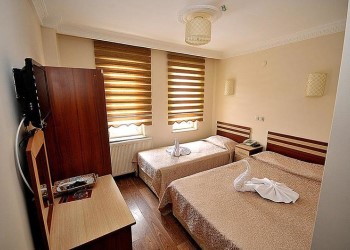
The hotel is a mid-range hotel near one of the best neighbors of Isfahan, Chabar Bagh Boulevard.
The hotel was founded in 1992 and later renovated in 2016. A total of 100 rooms are single, double, and triple rooms, spacious apartments and suites.
All rooms are equipped with TV, air conditioning system, WI-FI, safety box, and laundry service.
Other hotel facilities include Diplomat Salon for conferences and seminars, swimming pool, and traditional Iranian hammam, massage, and fitness centers.
Read more: Five Best Isfahan Hostels, Enjoy the City on a Budget
Best time to visit Isfahan
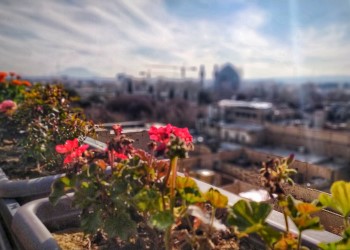
Located in the center of Iran, Isfahan has hot summer, and temperatures during summer months reach a maximum of around 39℃.
In winter, temperatures usually get down to an average minimum of 0℃.
The weather in this city is dry.
April, May, September, and October may be the best time that you can visit this legendary city.
Local foods and desserts
Beryani
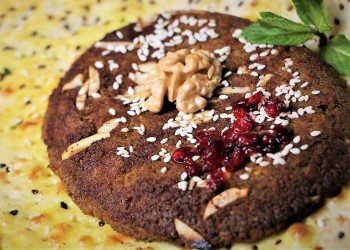
Biryani or beryooni is one of the traditional cuisines of Isfahan that you can only find in this city!
It is a kind of fatty meat in the form of a hamburger (bigger than standard hamburgers) and has a browned crust but it is very soft.
It is served as the main course with bread and onion.
Shoulder and rack of mutton, mutton lungs, onion, saffron, turmeric, cinnamon, salt, and paper and dried mint leaves are the ingredients of this delicious food.
You can find beryani only in Isfahan. So do not miss the chance to try this delicious food whenever you travel Isfahan!
Khoresht Mast
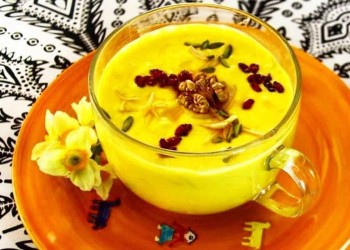
Literally means yoghurt stew, khoresht Mast may surprises you. With its bright yellow color, this sweet dessert and mostly served as a side dish.
Lamb neck, sugar, saffron, yoghurt, pistachio and almond slices, barberry, rose water and salt are the main ingredients of this dish.
Remember this is also a delicious food that you can only find in Isfahan. So order this delicious dessert while having a meal in a restaurant in this historical city!
Read more: Best Iranian Drinks and Beverages that You Should Not Miss!
Souvenirs and handicrafts
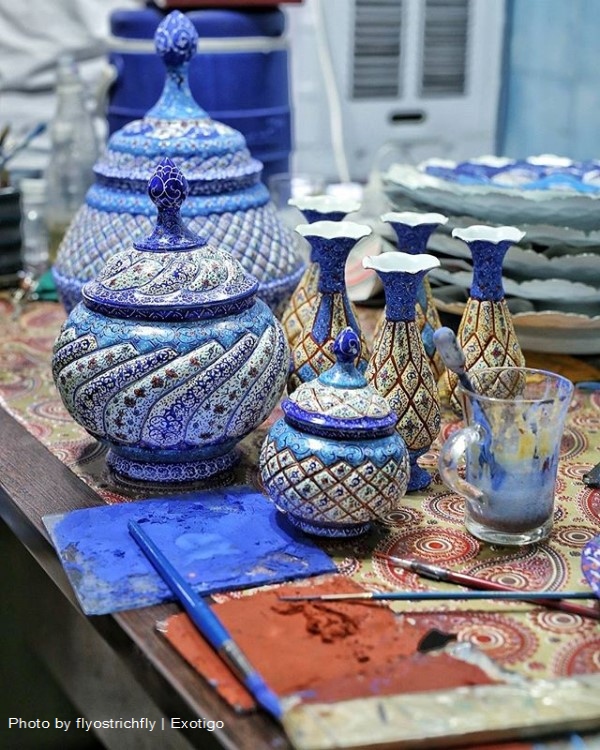
Isfahan is the city of handicrafts like Minakari (metal enameling), Qalamkari (stamp printing), Khatam Kari (Inlaid objects), and Ghalamzani (engraving). There are some workshops that you can witness the process of making handicrafts and try a hand!
Minakari
This delicate beautiful handicraft called Minakari or metal enameling is the art of painting and on the surface of metals, which can be gold, silver, or copper by glazing colors and fire in the furnace.
It is usually done on vases, picture frames, and plates, jewelry, small decorative objects. One of the meanings of Mina in Persian language is “heaven”. However in fact it is a glasslike coating fixed on different kinds of metals by heat. It is available in different colors, such as azure blue, purple, black, yellow, green, and gold and cyan. Azure blue and turquoise are the popular colors that you can see in Isfahan handicraft.
Qalamkari
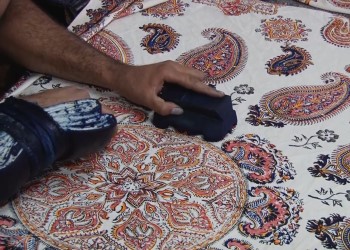
It means craftsmanship with a pen. In fact it is the art of stamp printing.
To do it on cotton, there are 23 steps including dyeing, bleaching, hand painting, block-printing, and starching.
Indigo, mustard, rust, black, and green are the main colors used in this handicraft.
Paisleys, flowers, and birds are the main motifs you can find in the artifact.
Khatam kari
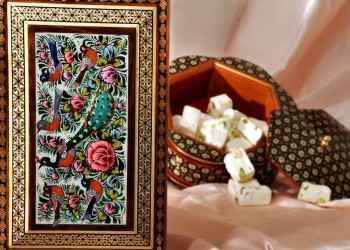
In Khatam kari, an incrustation patterns (which is usually star-shaped) is made with thin sticks of wood, brass, and white parts of camel bones (white parts).
These sticks are assembled and glued in a strict order to create a geometrical motif.
Khatam kari is used for decorating boxes, frames, musical instruments chess or backgammon, frames, or even musical instruments.
Interestingly, during Safavid era, it was a royal art, which is learned by princess and members of courts.
Qalamzani
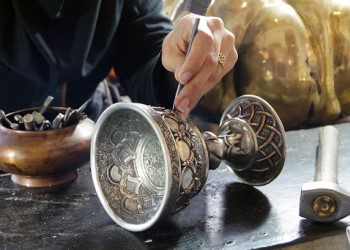
It is a combination of different kinds of art. First of all someone should draw a picture.
After that, the main lines of design would be traced by carving chisels, which usually takes time according to the size of the piece.
It needs the skill and patience to make good work in this kind of art.
It needs different instruments including a hammer, hand-made instruments, and chisels. Most of the time engraving is done on both sides of metal.
Gaz
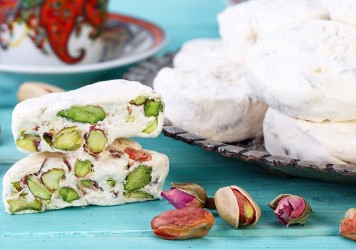
Do not leave Isfahan city without tasting the delicious sweet, Gaz!
It mainly from the sap of angebin, a plant that mostly grows in the Isfahan region and is known as Isfahan’s souvenir.
Today, this Persian nougat is made of egg whites, sugar, and pistachio are added to Gaz nowadays. However, high-quality Gaz has a high percent of angebin, and different amounts of pistachio add to it.
Poolaki
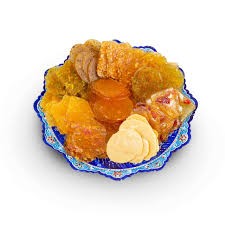
Pulaski is another kind of sweet which you can find in Isfahan. Poolaki is like a thin disk and is round sugar, water, and white vinegar are the main ingredients of this delicious sweet.
Poolaki is sometimes flavored with saffron, dried lime, and cocoa powder.
The sweet is a great choice for drinking tea. So if you travel Isfahan, do not forget to try this tasty sweet!
Read more: Top 20 Iranian Foods You Should Not Miss!
Restaurants and cafes
Azam Beryani
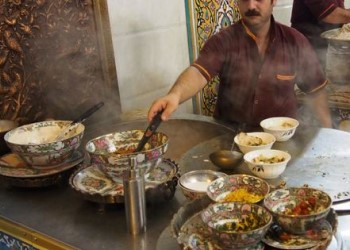
This place specializes in Beryani.
So it is a great choice during your sojourn in Isfahan.
Made of shoulder and rack of mutton, mutton lungs, onion, and spices, Beryani is a food that you only try in Isfahan.
The restaurant serves lunch and serves Beryani with a special appetizer named Ab-goosht.
Address: Kamal Ismail Street Next To The Gas Station, Isfahan 81464, Iran, +98 31 1212 5730
Azadegan café
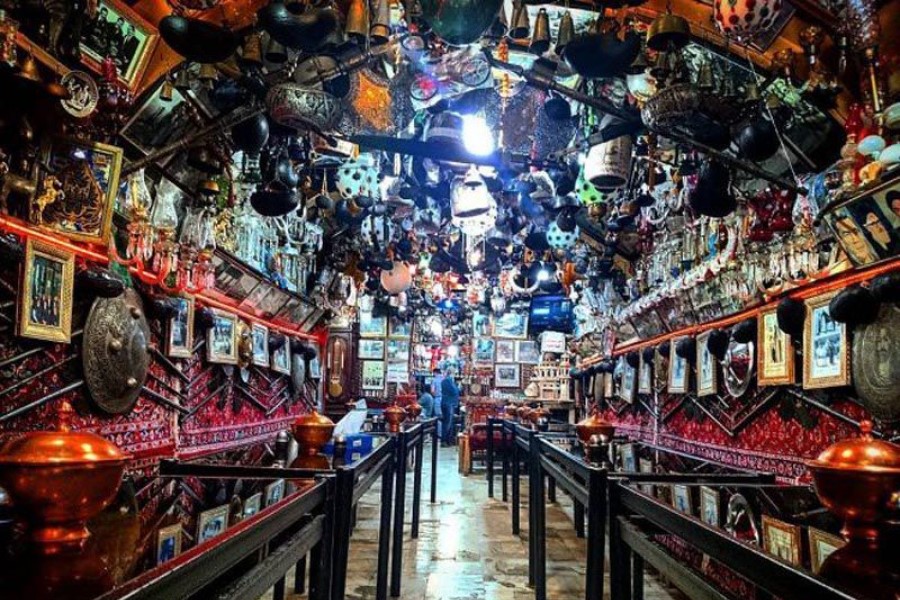
Without any doubt, one of the most unique and special teahouses in Iran. Azadegan cafe also known as Chah e Haj Mirza teahouse is located at Naqshe Jahan square, and almost everyone in Isfahan knows this cafe.
What makes this teahouse an exotic place to visit, is the collection of antique elements they hung on the wall and roof and tastefully decorated the interior. you will immerse watching all of them for a while.
You can have a meal and also dessert at this café as well. Goosh-e Fil and Doogh are some of the things that you can try at this place. You may find it crowded but it is a vibe café and you can enjoy taste of everything you order.
Address: Chah Haj Mirza alley, Emam Sq, Isfahan 81464 Iran, +98 31 3221 1225
Shahrzad Restaurant

As one of the oldest and popular restaurants in Isfahan, Shahrzad is the feast of eyes as well! With mirror work and traditional decoration, you can enjoy the atmosphere besides the tasty foods and desserts.
The kebabs are well-known in this restaurant. So you can have a great tasty experience at this place!
Address: Abbas Abad Street, Isfahan 8134616811 Iran, +98 31 3220 4490

